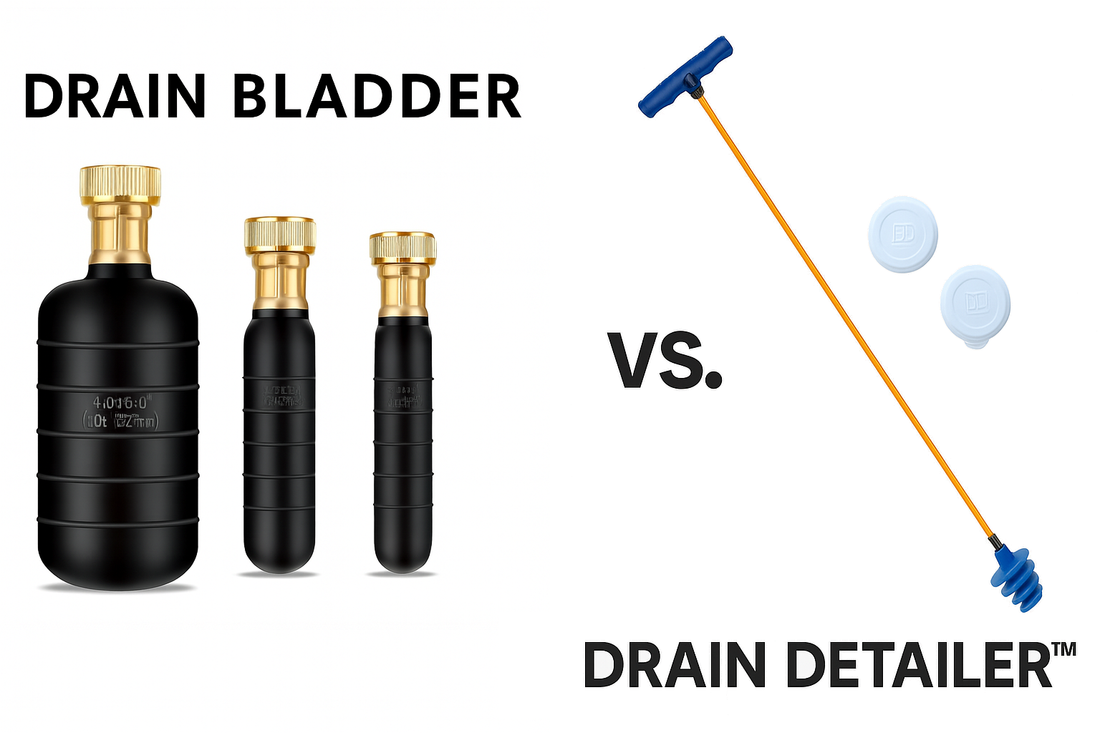
Drain Detailer vs. Drain Bladders
Why the Drain Detailer™ Is Safer (and Smarter) Than Drain Bladders for Bathroom Sinks
Short version: Drain bladders (a.k.a. blow bags, flush bags) use household water pressure to force clogs down the line. The Drain Detailer™ physically removes buildup from sink drains without water or chemicals—so there’s no pressure surge, no flooding risk from a burst bag, and no guessing if the clog actually left the pipe.
What’s a Drain Bladder?
A drain bladder is a rubber sleeve you connect to a hose. It expands to seal the pipe and then blasts pressurized water forward to push a clog downstream. They can work in large, accessible drain lines, but they’re not ideal for bathroom sinks.
Common Issues With Drain Bladders in Sinks
- Pressure & burst risk: Household water pressure (often 40–80 PSI) can split a worn bladder or weak joint—resulting in a surprise indoor geyser.
- Flooding & mess: If a connection pops or a sink/overflow can’t vent fast enough, water backs up into the vanity and floor.
- Pushes, doesn’t remove: Bladders often push clogs deeper instead of getting them out of the pipe, so the problem returns.
- Not friendly to old/fragile plumbing: Pressure can stress aging traps, slip-nuts, and seals.
- Setup & hygiene complications: Indoor hose runs and cross-connection/backflow concerns make bladder use in bathrooms awkward.
Why Drain Detailer™ Is Better for Bathroom Sinks
- Removes the clog instead of pushing it: You take off the P-trap, insert the tool from the sink, and push the debris out the bottom of the pipe (where the trap was). You can see it leave.
- No water, no chemicals: Safe for pipes, finishes, and septic systems; no caustic residue or pressure spikes.
- Purpose-built for sinks: The tool targets the hair, soap-scum, and toothpaste film that typically narrow sink drains.
- Cleaner, safer workspace: Use the provided sewer-line cover while the trap is off to block sewer gases. When finished, refill the P-trap with water to restore the odor seal.
- Reusable & economical: One tool, many cleanings—no bottles or single-use bags.
How the Drain Detailer™ Works (Quick Steps)
- Place a bucket under the vanity. Remove the drain cover and the P-trap.
- Cover the wall-side trap arm with the sewer-line cover to block gases.
- Insert the tool down through the sink drain and guide it to the open trap connection.
- Push the clog and buildup out of the pipe into your bucket. Detach the cleaning head if needed, then withdraw the rod upward.
- Run hot water to rinse, refill the P-trap with water, reinstall, and check for leaks.
Head-to-Head: Drain Bladder vs. Drain Detailer™
| Feature | Drain Bladder | Drain Detailer™ |
|---|---|---|
| Method | Pressurized water pushes clog deeper | Manual tool removes clog out of pipe |
| Risk of flooding/burst | Possible indoors (bag rupture, blow-off) | No pressure, no burst risk |
| Chemicals required | No chemicals, but uses high water volume | No water or chemicals |
| Best use | Larger, accessible drains (outdoors/cleanouts) | Bathroom sinks with hair & soap buildup |
| After-care | Mop up, check for leaks | Refill P-trap to block sewer gases |
When a Bladder Might Still Make Sense
For exterior cleanouts or larger lines where water can safely discharge and be monitored, experienced users (or a licensed pro) may choose a bladder. For bathroom sinks inside a home, the Drain Detailer™ is typically the safer, cleaner, and more reliable choice.
Make the Safer Switch
Skip pressure-based “maybe it worked” methods. Choose the tool that removes the clog and protects your bathroom.
Always follow local plumbing codes. If you suspect damaged pipes, call a licensed professional.
